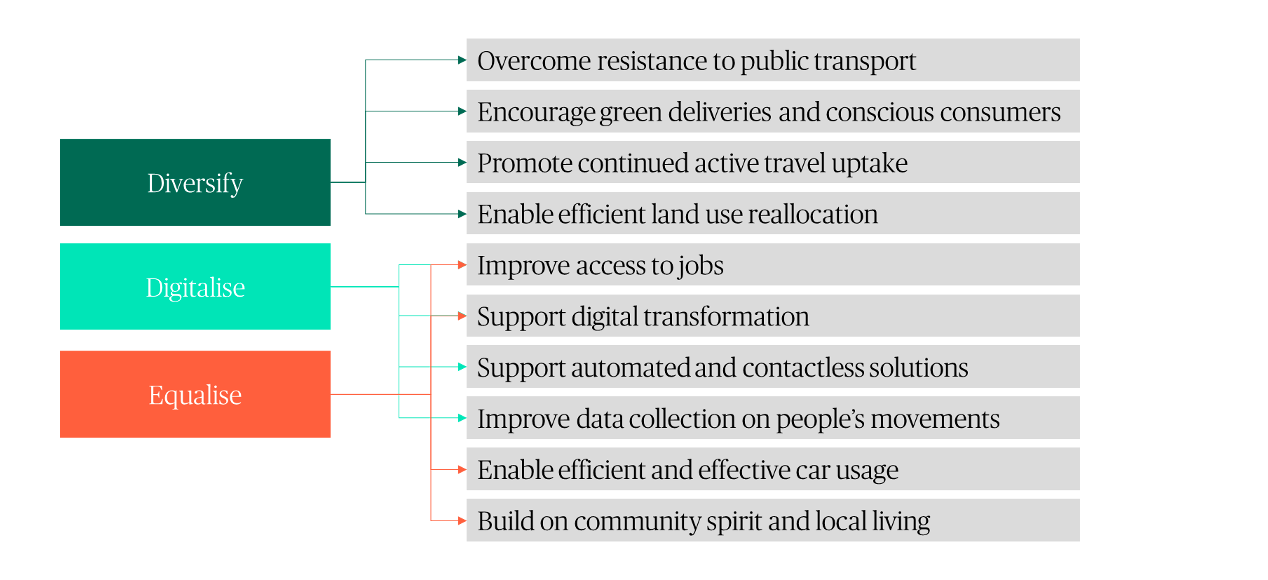Buckinghamshire Live Lab - what can Covid-19 teach us about resilience in local transport?
We are still discovering what long term impacts Covid-19 might have on local transport. In our latest guest blog, Georgina Box, Systems Engineer from Connected Places Catapult, talks through their work with Buckinghamshire Live Lab on what we can learn and take forward.
The short-term measures to prevent the spread of Covid-19 were drastic and - a word we have become well acquainted with over the last year - unprecedented. From social distancing measures to work from home mandates and from track and trace to the closure of shops and businesses, the pandemic restricted the way that we live our lives. As a result, these restrictions caused us to make significant changes to how we moved people and goods.
The immediate impacts saw more people than ever turn their living rooms into classrooms and sheds into offices, removing the need for school drop-offs and commutes. Many people took up cycling, especially as a leisure activity, a positive side effect to the limited entertainment options and quieter roads. As shops were forced to close their shutters, we saw an increased demand for online shopping and food deliveries, creating a huge growth in diesel van deliveries. Meanwhile public transport numbers plummeted as journeys numbers reduced and many felt the health risks of shared vehicles were too high to take.
Now, as Covid restrictions are almost a thing of the past and we begin to settle into the ‘new normal’, we need to be asking - what can we learn from the impacts of Covid-19?
At the Connected Places Catapult, we have been working with Buckinghamshire Live Lab to identify the residual challenges which are likely to outlive pandemic restrictions and the new opportunities which have arisen. We engaged with members of Buckinghamshire and Central Bedfordshire councils to understand their experience of changes to local transport throughout the pandemic and researched national and international best practice.
We found that improvements to the network operation could be achieved by focusing on three key activities:
- Diversification, for example introducing new modes such as e-scooters or expanding the coverage of bus services.
- Digitalisation, for example phasing out paper tickets to be replaced by smart ticketing and offering digital journey planning and timetabling.
- Equalisation, for example ensuring that active travel infrastructure is wide enough for wheelchairs and wheelchair bikes while ensuring that parking spaces or drop off points remain available to those who need them.
Our ten recommendations to ‘build back better’ and improve Buckinghamshire’s resilience to any potential future disruptions to the transport network fall into one or more of these activity groups; diversify, digitalise and equalise.

Through the investigations, we found great examples of rapid and effective innovation, taking advantage of the opportunities to create a new normal that is sustainable into the long term. A few examples include:
- Flexible ticketing which does not tie people into weekly or season passes but offers discounts for buying journeys in bulk (such as carnet ticketing) and can be redeemed over a longer time period as required by the user. This ensures that public transport remains affordable on a per trip basis as the hybrid working model between home and workplace becomes more popular.
- Co-working spaces in towns to attract people into urban centres to spend money in local shops and businesses. Co-working spaces provide an alternative environment to working from home which have optimal working conditions (quiet, fast wi-fi, meeting rooms), foster collaboration and socialisation and yet are still local, reducing commuting distance.
- Automated delivery solutions such as delivery robots helped reduce human contact from on-demand small goods deliveries during the pandemic, but can also provide cost and carbon savings into the longer term by reducing labour costs and removing tailpipe emissions through electrification.
- ‘Apps’ to do good deeds and small favours for neighbours which can lead to journey consolidation (one household shopping for two) and improve access to goods and services.
- Low Traffic Neighbourhoods to make urban and residential areas more attractive and safer to pedestrians, cyclists and micromobility users leading to safer, cleaner and more desirable places to live and work.
- Virtual high streets which are online platforms acting as a single point of access to a variety of independent local businesses, offering an alternative means of selling goods to physical shops.
The challenge now, is to really work to embed the changes made and to continue to deliver benefits. We will be working to take some of these opportunities forward and welcome any further ideas and collaborations from the ADEPT Live Lab network.
To find out more, download our report Impacts of Covid-19 on Local Transport from the ADEPT website. Have a look at our webpage and the Impacts of Covid-19 on Local Transport video.
